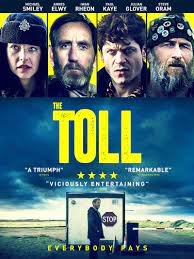Peter MALONE
Hating Peter Tatchel

HATING PETER TATCHEL
Australia/UK, 2021, 95 minutes, Colour.
Directed by Christopher Amos.
From the 1970s, Peter Tatchel was a controversial activist, establishing the organisation Outrage, a campaigner and crusader for LGBTQI+ rights. Not only was he a crusader, he was an active activist, protesting, in the public eye, promoting his cause.
Some commentators who enjoyed this documentary suggest it should be called Loving Peter Tatchel. And, there were many who did – and who will after seeing this favourable documentary though with an emphasis on warts and all. But, there have been many who hated him over the decades and will continue. However, the film vividly brings to mind the changes in attitudes over the 50 years that Peter Tatchell was active, from legislation against homosexual activity, from prejudice stances, to changes in public attitudes in many countries, to legislation on same-sex marriage. There has been considerable change. At the end of the film, there is a quite long list of the many countries with prohibitive legislation.
Some people might be surprised to find that Peter Tatchel is Australian, from Melbourne. There are photos and home movies from the period. His mother was a devout Christian, not approving homosexual orientation or activity. However, she is interviewed throughout the film, especially conversations with Peter, his tough-minded sister, and a mellowing in his mother’s attitude and her love for her son. But, his stepfather is seen as a cruel man, violent.
Like many Australian expatriates, Peter Tatchell moved to London and settled there. We see him at home, moving around London, at meetings of Outrage…
The framework of the film is a conversation he has with Ian McKellen (looking a bit like a scruffy Gandalf), but asking the personal questions, some moments of his being critical, but very sympathetic to Peter and his causes. There are other sympathetic interviews, especially with Stephen Fry.
Older audiences may remember news footage of Peter Tatchel’s protests and demonstrations, his placards, his standing in public view, the reaction of the police, several times being manhandled and his being hit (and his later saying that doctors have warned him against any more head injuries because of the effect on his brain). We see him in London. We see him in Russia. He denounces Putin – and, in 2018, went with a camera crew to Moscow again at the time of the World Cup. Stephen Fry notes that Peter Tatchel is expert at performance, and knows camera angles and lighting so that he gets the best effect for the interviews, the treatment he experiences, the role of the police. This is especially the case in his encounter with Robert Mugabe, wanting to make a citizen’s arrest in London, the episode shown twice, especially the physical brutality towards him.
So, the film is interesting for those who want to understand Peter Tatchel, for those who remember him. And, for those who don’t agree with him or his tactics, a reminder. This is symbolised especially by his demonstration against Archbishop George Carey iin Canterbury Cathedral, invading the pulpit during an Easter Sunday sermon, holding up denunciatory placards, indicating a number of Anglican bishops with homosexual orientation. George Carey was interviewed at the time, disapproving of the bullying tactics. However, he is again interviewed, 20 years later, not agreeing with all the tactics but indicating the good that Tatchel has done in raising consciousness – and even making a connection with the activity of Jesus himself and his social stirring.
The film is an Australian/BBC production, with finance from Screen Australia and various state screen organisations.
News from around the Provinces
News from around the Provinces

Philippines: Re-interment of Lope Castillo, who studied with us in Canberra and Croydon in the 1960s, twice Provincial.

Brazil Our Congregation of the Sacred Heart MSC Missionaries, we rejoice this weekend, with the ordination of two of our confrades: Wanderley Procópio Msc who was ordained deacon by Dom Valentim Meneses, MSC, bishop of Balsas do Maranh ãoo and Roney Lima Ordained priest, by Dom Manoel Santos Msc, bishop of Registro SP.

Italy: Our prayer of thanksgiving and praise goes up to God for the Perpetual Vows that Domenico Rosa professed on Sunday 25 July 2021 in Florence, in our Congregation of the Missionaries of the Sacred Heart of Jesus

Dominican Republic: New MSC Deacons: Jahuil Doroteo and Juan Corona.

On Monday, September 27, 2021, Deacons Jahuil Doroteo, MSC, and Juan Corona, MSC, were ordered by imposition of the hands of Mons. Hector Rafael Rodriguez, MSC, Bishop of the Diocese of La Vega. The ceremony took place in the Divine Parish Child Jesus, Las Praderas, Santo Domingo, National District.
You might like to read their stories.
Jahuil Alexander Doroteo Pereyra.
Born in La Romana on November 23, 1989. Son of Ramón Antonio Doroteo and Ridaliza Pereyra. His brother Rolfy Antonio Doroteo Pereyra. Jahuil started his vocational process in August 2009 at the Vocational Center in Licey al Medio, Santiago. That same year he took the Pre philosophy at the Seminar San Pio X. From 2010 to 2012 he studied philosophy at the Pontifical Catholic University Mother and Teacher, James. In 2013 he was sent to Santo Domingo to complete the pre-novitiate stage and continue philosophical studies. His new residence was the Mayor Seminar located in Palmar de Herrera.
Juan Gabriel Corona Estevez.
Born in Santiago de los Caballeros on October 7, 1989. His parents are Gabriel Antonio Corona and Onelia Angelina Estévez. His brothers Alexander and Arlenys Corona Estévez. Juan started his vocational process on August 21, 2010, at the Vocational Center, Licey al Medio. That same year he took the Pre philosophy at the Seminar San Pio X. In 2011 he entered the Pontifical Catholic University Mother and Teacher to specifically start his studies of philosophy, in 2012 he passed to the Palmar Missionary Seminar in Santo Domingo, there concluded philosophy at the Pontifial Seminar Santo Tomás de Aquinas ..
Jahuil and Juan performed their Novitiate in 2014-2015 at the MSC Vocational Center. August 1, 2015 was his first religious profession. On August 5, 5, they entered the Latin American Teologado in Central America, El Salvador. From 2015 to 2020 they studied theological studies at the Central American University José Simeón Cañas (UCA), earning the Bachelor's degree in Theology, and Ecclesiastical Bachelorhood from the Pontificia Comillas University of Madrid. His perpetual profession as Missionary of the Sacred Heart was on August 6, 2018 in the Parish San Luis Gonzaga, Mariona, El Salvador.
On November 4, 2020, Juan returns from El Salvador and joined pastoral work alongside the P. Miguel José Vásquez, (deceased) at the MSC Formation House, Los Prados, Santo Domingo. Jahuil returned to the country on December 10, 2020 and joined the pastoral work in Villa Jaragua, in the San Jose Obrero Parish alongside the P. Osiris Nunez.

Force of Nature/ 2020

FORCE OF NATURE
US, 2020, 91 minutes, Colour.
Emile Hirsch, Kate Bosworth, Mel Gibson, David Zayas, Stefanie Cayo, Tyler Jon Olsen, William Catlett.
Directed by Michael Polish.
This is familiar kind of American action entertainment, the kind of film is that Bruce Willis and Nicolas Cage were making and the 2010s.
The setting is Puerto Rico, during the hurricane, with reminiscences of the devastation from the hurricane in 2018 – and the critical and inadequate response of President Donald Trump.
This time the hero is Emile Hirsch, rather short in stature, not the Willis-Cage image. He has had a disastrous experience in policing, the accidental shooting of his girlfriend, partner. At times suicidal, he has moved to Puerto Rico to a desk job.
In the meantime, there is a setup for the criminals, an attack on an elderly woman, taking a painting from her strong box, shootings, and intentions to steal more paintings.
After an incident in a supermarket where Emile Hirsch and his partner attend as part of their mission to help evacuees during the hurricane, the rest of the action is in the apartment block where they take the man who caused upset in the supermarket. Also in the apartment is an elderly man who has the paintings and is the target for the theft. And, an ailing cop, played by Mel Gibson, and his daughter, a doctor played by Kate Bosworth (who is married to the director, Michael Polish).
Mel Gibson has been playing in the kind of Willis-Cage action dramas also – but, this time, just like his nervy Lethal Weapon actor, only 30+ years later, Mel moving towards his mid-60s, and portraying a man full of ailments.
- The title, hurricane in Puerto Rico, memories of the devastation from the hurricane and Donald Trump’s inadequate response?
- The Puerto Rico settings, the island, the overviews, the beaches, restaurants, police precincts, apartment blocks, the streets? Most of the action taking place in the interior of the apartment block? The musical score?
- Cardillo and his girlfriend, the call, the stakeout, the complainant, Cardillo shooting, his dismay, the sequence at home, the bath and contemplating suicide? The later visualising of the sequence again, the death of his partner, his girlfriend? The consequences?
- John the Baptist, the old lady in red, accosting her in the bank, her box, the painting? Shooting her, shooting his accomplices, people in the bank? His driver and escape? His plan to get more paintings?
- The hurricane, the police wanting evacuations, Cardillo asked to go, with Jess, his intention not to do anything, not to get police blame for complaints? The call to the supermarket? Jess responding?
- The supermarket, panic buying, Griffin and his buying all the meat, the complainant and his son, the scuffle, the manager, the police? Withdrawal of charges? Cardillo and Jess accompanying him to his apartment, for the evacuation? Griffin, his room, the locked door, the meat, the Tiger, Cardillo dragging him out? Audiences waiting for the final attack from the Tiger, the Tiger attacking John the Baptist?
- The people in the apartment, the old man downstairs, opening up, going upstairs to Griffin’s room? Ray, cop, his ailments, his daughter looking after him, doctor? The bond between them? His refusing to evacuate?
- The police handling the situation of evacuation, the hurricane increasing?
- The invasion of the criminals, John the Baptist and his gang, the old man’s room, the lock, finally the explosion, the basement, opening the safe, the empty safe? The search for the old man, the thugs and their guns?
- The response of Cardillo and Jess, of Ray and his daughter? Cardillo and Troy going for the medication? For Griffin’s leg after the tiger biting? The medication for Ray? The cat and mouse sequences, the thugs stalking, the confrontations, shootouts, Troy and her shooting training, Cardillo and the struggle with the man on the roof, pulling him over the edge? The impact of the action sequences and the shooting?
- The confrontation with the old man, his holding Griffin’s leg, Nazi background? The art treasures, his father and Nazi, bequeathing to him? Cardillo and persuading John the Baptist to come upstairs, the paintings in the secret room? The Vermeer in plain sight? John the Baptist wanting to open the locked door, Cardillo goading him, the audience wanting him to open the door, the tiger to come out – and the impact?
- Ray, putting on his vest, shooting, the confrontation on the stairs, his daughter attending him, his death?
- An entertaining action pastime show?
Alex Wheatle/ Small Axe

ALEX WHEATLE
UK, 2020, 66 minutes, Colour.
Sheyi Colel, Jonathan Jules, Khali Best, Elliot Endusah, Robbie Gee.
Directed by Steve McQueen.
This is a brief film, a contribution to Steve Mc Queen’s television series, Small Axe. The series focuses on the experience of West Indian migrants and the next generations in England, especially in London.
Alex Wheatle, of the title, is a writer, who has received Queens honours. This is his story, going back to his being orphaned, never hearing from his mother, going into institutions, bullied by white foster-figures. Eventually, although from African background and from Surrey, he settles in the late 1970s in Brixton in the West Indian community, making friends, interested in reggae music, becoming socially-minded, involved in the Brixton riots in 1981, serving some time in prison.
Steve Mc Queen’s films are a reminder of racism in past decades in the UK as well as a reminder of significant figures who have emerged and contributed to British life.
- This contribution to the Small Axe series?
- The London setting, the 60s and 70s and foster care, institutions? The 1980s, Brixton and its neighbourhood? The Brixton riots? Prison? Musical score?
- Audience response to the West Indian accents, some difficulties in deciphering?
- Alex Wheatle and his story, his background in upbringing, African- British background, absent parents, harsh treatment in foster care, anger at school, his love for reggae music? Older teenage, released, going to Brixton, friendship with the Denis, Denis teaching him the ropes, the swagger, drugs, music? Alex settling in, his flat, coming from Surrey, the contrast with the West Indians? Friendship with Dennis, the music, introduction to other friends, the drugs? Dennis and the family meals?
- The framework of Alex going to prison, his anger, resentment, the Rasta cellmate, anger, guilt and reaching out, explanations, his way of life, the music? The gradual friendship?
- The background of racism in the 70s and 80s in London, political, social?
- The riots, particularly strong in Brixton, the explanations, the visualising, the angers, the destruction, the consequences? The extensive use of contemporary footage and its dramatic impact?
- Alex, his involvement, passion, in prison?
- Alex Wheatle and his reputation, writing, Queen’s honours?
Malignant

MALIGNANT
US, 2021, 111 minutes, Colour.
Annabelle Wallis, Maddy Hasson, George Young, Michole Brianna White, Jean Louisa Kelly, Jake Abel, Jacqueline McKenzie.
Directed by James Wan.
Malignant is a top title for a horror film. It has evil inbuilt in the very word. Malignant is malign and malevolent. And that is to the fore in James Wan’s most recent horror contribution (Wan being the director of the original Saw as well as directing two Insidious episodes and two Conjuring episodes and producing a great deal more – though varying his interests and style with DC Comics’ Aquaman and its sequel.)
Malignant can refer to an unwelcome growth like cancer. Malignant can also refer to grimly hostile attitudes. Both are relevant in this story.
The film opens with Dr Weaver, played by Jacqueline McKenzie, talking to camera about the work she is doing with special children when she is interrupted by one of them having a violent outbreak. He wreaks violence, killing staff, eventually bound down. But, Gabriel does not remain bound down and makes increasingly ominous re-appearances in the present day! In Seattle (Will a lot of rain and downpours sequences).
Our focus of attention is on Madison, pregnant, arriving home from work, a clash with her alcoholic husband and a violent response for him, knocking her against the wall, hitting the back of her head – which, we will eventually realise, has some devastating consequences. Madison goes to hospital, loses the baby. But, she is disturbed by a sinister presence that she has experienced in her house. Her sister, Sidney, is supportive (Maddie Hasson). A detective, K (George Young) is earnestly sympathetic while his partner, Regina (Michole Brianna White) remains steadfastly cynical, especially as regards any theories that call in the mysterious, the psychic.
The film goes along steadily in this vein but, about halfway through, the tension rises significantly, Madison experiencing being present when Gabriel, sinister, tall, black, flowing hair, face undiscernible, wreaks vengeance on Dr Weaver. Madison is at home but, with effective special effects, walls come down and transform into the room where the killing is taking place, Madison witnessing. And this recurs several times.
We are now in the horror vein, Gabriel let loose, the detective pursuing him through the streets, into subterranean ruins of old buildings. And Gabriel shows no mercy, and a dreadful propensity for massacre, of medical staff, of police in the precinct headquarters.
While this continues the horror conventions, the film moves back into the science field, and takes on something of science-fiction aspects while offering a great number of scientific explanations, the family and the detective researching documents, Sidney going to a most sinister abandoned building where the treatment of the children took place, finding videos with Dr Weaver spelling out what happened.
The solution has frightening elements in itself, Madison and her relationship with Gabriel, the story of her mother and her adoption, medical treatment – and the building up of a psychic and physical confrontation between Madison and Gabriel.
Here is a horror film which takes itself seriously, using the conventions but presenting them in an upmarket style, inviting a broader audience than just the fans.
- The title? An intrusive growth? Malevolent intentions?
- The work of the director, his contribution to the horror genre?
- The Seattle setting, the city, the 1990s, the present, the views of the city, the countryside, the enormous Institute abandoned, dark interiors? Police precincts? Hospitals, surgery rooms? The rain in Seattle? The musical score?
- The prologue, Dr Weaver, the tapes, information, Gabriel, his, gruesome killings, his being tied down? The later return to Dr Weaver, her career, her trying to help children, difficult children? Gabriel and his gruesome attack on her? Her later being seen in the videos? The other doctors, their contributions, collaboration with Dr Weaver, later decades, their gruesome deaths?
- The introduction to Madison, pregnant, home from work, reactions of Derek, his drinking, turning on her, the violence? Madison hitting her head on the wall, the blood? The explanation and the later consequences? In the night, the mysterious presence, her going downstairs, the attack on Derek, his grim death?
- The police, K, Regina Moss, the investigations? Madison and suspicions? Hospital, the loss of the child? Her previous miscarriages? Her grief, wanting a blood bond, the story of her adoption? Sidney, her sister, coming to visit, support?
- The woman in the attic, tied up, Gabriel’s presence, taunting, her getting free? Eventually collapsing through the roof? In hospital?
- Madison, the story of her adoption, her not remembering prior to the adoption? The story of her mother, 15, pregnant, allegedly dying, giving the daughter up for adoption? The revelation of the woman in the attic, Madison’s mother? The revelation through the videos, the explanation of what it happened?
- Madison, the bond with her sister, memories of the past, home movies, birthdays and celebrations? But Madison and her malevolence, talking to her mysterious friend? The reaction of her parents? The love for her, overcoming her bad memories and the link with Gabriel?
- The visits to her mother, talking with her mother, explanations?
- Madison, going home, her experiences, the blood from her head? The transformations, her being present at the killing of Dr Weaver, of the other doctors? K and his sympathetic investigations, attraction towards Sidney? Regina Moss, hardheaded, sceptical, not believing in anything psychic?
- K and his studying the files, identifying Madison as one of Dr Weaver’s patients? His being too late to prevent the doctor being killed?
- Sidney, the visit to the Institute, large, abandoned, eerie, getting the files, watching the videos?
- The hypnosis sequence, taking Madison back into the past, her real name, identity, Gabriel’s continued presence?
- The revelation of the truth, the visuals of the young child, Gabriel as a twin, parasite, in the back of her head? The surgical attempts to rectify the situation? behaviour Enabling Madison to live an ordinary life? The injury to the back of her head, reactivating Gabriel?
- The visuals of Madison/Gabriel, monstrous? Two-faced, the camera moving from one face to the other, malevolent, malignant? Aggressive, the death of the doctors, K and his long pursuit in the corridors, down the scaffolding, through the underground?
- The final visual confrontations, the dead police, Regina being injured, K, Sidney and the table on her? Sidney and her reaching out to Madison, to take control, to destroy Gabriel?
- Effective horror conventions? Interesting science fiction – and the elaborate medical and scientific explanations for science fact?
Candyman/ 2021

US, 2021, 93 minutes, Colour.
Yahya Abdul-Marteen II, Tatiana Paris, Nathan Stewart-Jarrett, Colman Domingo, Kyle Kaminski, Vanessa Williams, Brian King, Miriam Moss, Rebecca Spence.
Directed by Nia DaCosta.
Candyman was a popular horror film of 1992. It was based on a story by veteran horror writer, Clive Barker. 30 years on, we now have a sequel.
The Candyman story is a particularly American horror story. It is also a particularly African-American story, the main characters being African-American, with themes of white racism. The story makes quite an impact in the United States while non-Americans are more in the position of observers.
One of the distinctive features of this story is the use of puppet outline characters to illustrate and tell a variety of stories about the Candyman legends. (They are reminiscent of the Wayang puppet outlines used so effectively long ago in Peter Weir’s The Year of Living Dangerously.) They offer opportunities for characters to tell the story of the original persecution of a black man in the 19th century, his return to haunt. They offer opportunities for other stories about Candyman victims, as well as giving some continuity to the original film where Virginia Madsen was a research student, Helen, but whose story now is that she was caught up in the myth, becoming its victim, transformed, consumed in a fire but saving a young child.
To illustrate the story, there is an episode from the 1980s, a young child encountering a Candyman who offers candy – and the police swooping in to attack the Candyman. Now, this child has grown up to be a janitor, William Berke, in a building and a laundry, and who will have sinister action in this story.
The setting is Chicago. An area called Cabrini Green, a black neighbourhood last century, then pulled down, rebuilt and gentrified, a white presence rather than a black presence. We are introduced to the central character, Anthony McCoy (Yahya Abdul Marteen II), an artist, living with Brianna, a gallery manager. He is running out of inspiration but ambitious for a show – and listens to a story told by Brianna’s brother, the story of Helen and Candyman. Which leads him to go to Cabrini Green, to find inspiration, to explore the story, and an encounter with William Burke. While there, he is stung by a bee, bees associated with the Candyman story, and his hand becomes infected, the infection growing up his arm towards his face.
The mythology of Candyman spreads, chanting his name five times in front of a mirror – with dire consequences, especially for a group of schoolgirls who experience Candyman is vengeance.
The film shows the torment of Anthony, fearful of mixing with people, the death of his art critic friend, the fear of his partner, his visit to his mother and discovering his identity (the baby saved by Helen), a visit to William Burke who wants Anthony to be the current Candyman.
As said, the appeal to it as an American audience, especially an African-American audience, but offering horror conventions to those who enjoy this kind of legendary exploration.
- The impact of the original film? 1992? The character of Candyman, his origins? Helen and her investigations and the consequences? The racial issues?
- This film as a sequel, going back to manifestations of Candyman, the mythology and the mystique, the racial issues, Cabrini Green and the gentrification, the 21st-century situation?
- The device of the puppet outlines, throughout the film, telling stories, illustrating the stories? The telling of the story of Helen, her investigations, her being possessed, the consequences, the baby rescued, her death in the fire? Her voice recurring throughout the film?
- The race issues, Cabrini Green, the black neighbourhood, the boy and his encounter with Candyman, the taking over of the area, rebuilding, gentrification, a white community? The relegation of the black community? Especially the boy as he has grown older, janitor work? The laundry?
- The introduction to Anthony, his relationship with Brianna, his art, career, reputation? Her working at galleries? The visit from Troy and Grady, telling the story of Helen? The story of Candyman?
- The later episodes about Candyman, the puppet imagery? Back to the original man, the 19th century, the white killings? The various other men, possessed?
- Anthony, his personality, needing inspiration, the story of Cabrini Green, his visit, the encounter with William Burke and listening to his stories? The episode with the candy, the razor blade? The bees, Anthony being stung, the gradual deterioration of his hand, into his arm and face? The mirror, his art? The shock of the death of the couple? His visit to the art critic, discussions, her comments, the audience seeing her struggle in the window as the camera receded?
- Breanna, her work, discussions, meetings, plans? The meal, Anthony and his erratic behaviour? His disappearance?
- Anthony, his art, the series of paintings? The consequences for him?
- The mantra of saying Candyman five times in the mirror? The episode with the teenage girls, in the restroom, the mantra, the locked door, the consequences and their gruesome deaths?
- Anthony, the visit to his mother, the explanation that he was the child rescued from Helen? The consequences?
- Anthony, becoming desperate, the meetings with Brianna? Her searching him out, going to Cabrini Green, captured, watching Burke, Burke wanting to preserve Candyman, turning Anthony into Candyman, even to the sawing off of his arm, the insertion of the hook? Brianna getting away, seeing Anthony as Candyman, the confrontation with the police, the massacre? Her killing Burke?
- Brianna and Anthony, trying to calm him down, Candyman consuming him?
The MSC Province of the Pacific Islands – a growing region. Pre-Novitiate Program
The MSC Province of the Pacific Islands – a growing region
Pre-Novitiate Program
Warren Perrotto MSC, Pre-novice Master
If memory serves me correctly, in the January Fiji Diary, I was asked to be the Pre-Novice Master. Fr. Pone Luatuanuu, MSC, and Br. Colin Sinclair, MSC, and I coordinate the program.

In 1992, the MSC Formators met in Valladolid to discuss the congregation's formation programs. This meeting resulted in their formulation of what is known as the Valladolid Documents. It notes, the purpose of the pre-novitiate program is to help the candidate make a free and deliberate choice between the Christian states of life, to facilitate his human and spiritual growth, and to allow the community to assess the motives and readiness of the candidate for religious life. Normally this necessitates an experience of living in an MSC community for at least one year. (MSC Constitutions, 80, Guidelines for Formation, Valladolid Conference (VC), Spain, 1992.)

This stage of formation begins a journey to be a Missionary of the Sacred Heart (MSC). Thus, the prime motive of the candidate is to be an MSC. The pre-novitiate program begins planting the seeds for growth in the candidate's human and spiritual development. The Director and community members assist him in developing as an "integrated and integral human being." (VC, 1.1) The novice, indeed, is he, himself, the formator. His formation, thus, requires self-discipline, self-perception, openness for change, with a deep, internalised spiritual foundation to be one with the Sacred Heart, to be within and through His Sacred Heart, to be in Mission with the Sacred Heart, and to be His heart in this fragile and broken world.

Assessment of the pre-novice to move into the Novitiate Program involves evaluating his growth in his Emotional Maturity and Spiritual Life to be like Jesus "who loved with a human heart." Developing a Missionary Spirit is vital for becoming an MSC with a worldwide, integral mission to make the Sacred Heart known and loved everywhere. The novice must display a deep love for all persons with concern and compassion. Community living and community building are constituent elements of the Consecrated Life. Members must learn how to relate well with each other with charity and kindness. Intellectual Development and a Healthy Lifestyle likewise have a significant status for an MSC. Lastly, the novice is expected to have a growing sense of commitment to live the Consecrated Life as a Missionary of the Sacred Heart.

Here in Fiji, yours truly has "accompaniment" with the pre-novices every two weeks and group discussions, which include discussing concerns, evaluating the program at this moment, and evaluating their formator. They participate in the morning liturgy and community prayer with the professed members. They are to help with meal preparation for morning breakfasts and weekends. On Mondays to Fridays, they have three classes. The first is on the Consecrated Life, followed by two English classes. On Wednesday, Father Pone teaches Temporary Professed with the
Scripture. Br. Colin prepares the "examine" each evening. Tuesdays and Thursdays are workdays, and Mondays and Wednesdays are recreational days. Private prayer and study are required each day. This year's lessons on the Consecrated Life included MSC charism and spirituality, history, human development, human sexuality, and the meaning of the vows. (The vows and the Constitutions are more intensely examined in the novitiate setting.) In addition, the novices are required to give reflections during the Eucharistic celebrations. In English classes, they learn grammar, composition, how to provide oral reports and have debates. They learn to evaluate each other realistically after each does his presentation.

Visit the Pacific Province website to read about each of the seven pre-novices and their vision.
Toll, The

THE TOLL
UK/Wales, 2021, 83 minutes, Colour.
Michael Smiley, Annes Elwy, Iwan Rheon, Paul Kaye, Gary Beadle, Steve Oram, Gwyneth Keyworth, Dewi Morris, Julian Glover.
Directed by Ryan Edward Hooper.
Would you like a cinema visit to Wales? To Pembrokeshire, to be precise? Lots of open fields, wonderful vistas of the sea, cliffs and sand… But, the graffiti on the sign of Welcome to Pembrokeshire says “the English come here to die”. In fact, some English characters do come and they do die. But, in a spirit of equality, so do many of the Welsh characters!
Isn’t English a strange and ambiguous language! For whom the bell tolls. The toll from the disaster… Paying your toll… Actually, the toll of the title is a small remote cabin on the road down to the port where we can get a ferry to Ireland. It costs 40p for the toll-keeper to press his button and let you through. Actually, when a group of masked triplets from the town hold him up, he has only £1.20 to give them.
You may be perceiving the vein of this comic thriller with the previous observations. But, to really appreciate the vein, one has to draw on that frequently used phrase, a kind of cover-all for this kind of caper, Tarantino-esque. Well, as far as you can have Tarantino-esque in Pembrokeshire. And, to reinforce an impression, the music behind the final credits is Morricone-esque. (Somebody has already commented, of course, Rarebit-Western!).
Michael Smiley has been in a lot of dramas (the cowardly doctor in the Gunpowder Milkshake). He wasn’t cast in the role as the toll-keeper because of his surname. He looks perfectly ordinary, reserved, taciturn, living for 29 years in his tollbooth, reading his books, definitely never smiling. (An enjoyable smaller spoiler, he does smile in the last 30 seconds of the film!).
The other main character is Catrin (Annes Elwy), running this part of the county’s police force almost single-handed, with her driving around in a van and answering calls for a terrorist raid on a local business (actually, it is only those masked triplets again!), holding up her radar on an almost deserted road, she is the person of integrity in the film (but, there’s that final minute).
The writer, Matt Redd, is from Pembrokeshire so knows his people and locations. But he has a creative tongue-in-cheek way of introducing characters, a suave gentleman who turns out to be a gangster, too rather idiotic criminals, she bulky and black with a seeming American accent and he, scrawny, unable to speak, simply squeaking and mumbling out his ideas, the locals, especially the father of the triplets, a young smarmy conscienceless gangster on ready call to do any odd jobs, murder not excepted, and a grisly old truck driver involved in smuggling. (And there is a joke about the smuggling when those taking delivery discover they have a truckload of eye-pads instead of iPads!)
At one stage the toll keeper says the chronology is hard to remember as he recounts the events of the day to the young policewoman. And, there are various twists, betrayals, some gruesome vendettas, a spaghetti-Western (sorry, Rarebit-Western) final shootout. The title, the toll, could have referred in fact to the final body count!
If you’re in the mood for this kind of generally quiet satiric look at crime and criminals in Pembrokeshire, it becomes less quiet – but an enjoyable pastime.
- The title? The tollbooth? The toll keeper? Eccentrically Welsh? Yet the sinister undertones, episodes and violence?
- And the blend of the comic touch with action thriller? Welsh style? The Quentin Tarantino style?
- Pembrokeshire, the county, the small town, streets, shops, bar? The tollbooth and the heart? The open roads, the woods? The musical score?
- The toll keeper, quiet, age, personality, alone, 29 years, reading, the few passers-by, the barrier and the switch?
- The structure of the film “the Tarantino influence in shifting times? The episodes of the day? The juggling of the episodes, the flashbacks? Intercutting? The effect? The difficult chronology?
- Katrin, police, so few, with the radar on the road? Calls? The masked triplets on the raid on the store? Visiting the toll-keeper, the interrogation, his telling the story, the flashbacks?
- The suave gangster in his car, going to Ireland, recognising the toll-keeper, contact with Magnus? His being overpowered, tied up? The two receivers and the toll keeper introducing them, his shooting the gangster? They’re burying him? Waiting for Magnus to arrive?
- The triplets, their father, on the spree, their masks, robbing the store, confronting the toll-keeper, only £1.20, taking his watch, the sandwich? The toll-keeper contacting Don, Don pursuing the triplets, the crash and their deaths, retrieving the watch and the sandwich?
- Don, local criminal, available, cheeky attitude, working with Cliff? The smuggling? The truck?
- The family, associates, the news about the death of the triplets, pensions, on the rampage, the pursuit of Dom, torture and killing him, hanging from the tree?
- The smuggling, the humour about the high-pads and the iPads? The two criminals, the big burly woman, the scrawny man and his screeching and mumbling? The toll-keeper underestimating them, their betraying him, being paid off?
- Magnus, arriving, the gangster boss, memories of the past, 29 years, the confrontation? His thugs? The family the triplets? The violent confrontation, the shootings, deaths? In the toll-keeper surviving?
- The conversation with Catrin, the toll-keeper saying he knew who was responsible for the hit run death of her father (her buying the flowers, the visit to the can on the road close friend? The revelation of Mr Henry as the killer? The toll-keeper and his bargain with her, vengeance?
- Things resuming, keeping the toll? Katrin with her radar?
- The effect of this kind of blend of comedy and thriller?
Stray/ 2020

STRAY
US, 2020, 72 minutes, Colour.
Zeytin, Nazar, Kartal.
Directed by Elizabeth Lo.
If it’s dogs you are after, look no further. Even the dogs, named above in the credits, have their photos in the IMDb cast-list! - And are identified as “self – stray dog”.
The setting is mainly is Istanbul, with some ventures into the Turkish countryside. And we are given information that from 1909, the Turkish government had made determined efforts to rid Istanbul of its myriads stray dogs – unsuccessfully, it would seem, until there was pressure to change the legislation and allow the strays the freedom to stray.
Director, Elizabeth Lo, who serves as her own cinematographer, obviously has a passion for photographing dogs. And, for an audience which enjoys looking at dogs, admiring them, sometimes amazed at their behaviour, this film is quite an indulgence. Interestingly, the star dogs always look so well-groomed even as they wander the city. And, there are close-ups, enabling the dogs to manifest their personalities.
Scattered throughout the film there are also some quotations from the Greek philosopher, Diogenes, critical of humans and their behaviour and an exhortation that we should study canine models.
Which means then that we follow the three dogs, one wandering the city, another more friendly towards humans, and a nice puppy who takes refuge with a group of workers. And, throughout the film, there is a group of children, on the streets, homeless, drugs, quite a contrast in their straying with that of the dogs.
Normally on a Sunday in the park near where this reviewer lives, a large number of dog enthusiasts gather for training and tutorials. And, during lockdown, there were many humans and dogs for their daily exercise in the park. Which probably means that there is quite a substantial audience for this film throughout the suburbs, throughout the cities, in the towns and countryside. (But, a reminder and caution that there are those who are impervious to the charms of dogs, any dogs!)
Imperfect Murder, An

AN IMPERFECT MURDER
US, 2017, 72 minutes, Colour.
Sienna Miller, Alec Baldwin, Charles Grodin, Colleen Camp, John Buffalo Mailer, Nick Matthews, James Toback.
Directed by James Toback.
While it looks as if it might be a popular thriller, this is a film more for an arthouse audience – and the many denunciations by viewers, especially on the IMDb, indicate that it is not for a popular audience.
It might have fared better with its original title, The Private Life of a Modern Woman.
It is been directed by James Toback, controversial writer and director for many decades, beginning with such films as Fingers and moving into themes of gambling, desperate relationships. In fact, he appears early in this film as a film writer and filmmaker, having a conversation with the central character, Vera (Siena Miller), asking her all kinds of personal and existential questions about the meaning of life, her aims, her fears, pain, suicidal thoughts… Questions which are very personal, it would seem, to the director himself.
This is very brief film but is made up of a variety of episodes, many of which could stand alone.
The impact of the film depends on audience response to Vera and to Siena Miller’s screen presence and performance. She is disturbed in her sleep, a nightmare, wakes to find that the nightmare has been a reality. However, there is a question of how much is reality and how much is her writing the story, the audience hearing it in extended voice-over. A past lover, an unreliable drug dealer, has come out of prison, comes to her apartment, threatens her, there is an altercation, he has a gun, draws it, they struggle, she gets the gun, the intruder is shot. In her dilemma, she is confused. However, she puts his body in a huge chest – and, the next day, drags it down from her apartment, along the street in full view, rather a distance, to her car, where two men help her to put the trunk in the boot. She drives extensively, goes to a pier, drags the chest and pushes it into the river.
And, so, the audience asks is this meant to be real, is it in Vera’s imagination, is at her literary/fictional view of what happened. And, throughout the film, especially in the different episodes as she talks to the different characters, there are flashbacks to the intrusion.
Her first visitor is a man with whom she is in a relationship, who has completed his thesis on murder in Dostoevsky and Dickens and asks her opinion, she is brusque with him and he leaves. Then she is visited by the filmmaker, an extended sequence, philosophical questions and the equivalent of a monologue by Vera.
The next episode is from a police Inspector played by Alec Baldwin. She is calm, she plays off him well, is able to answer all his questions even as he tries to incriminate her.
The next episode is quite different, very much stand-alone. Vera has referred to her mother and her grandfather and they have been invited to a meal. This is a very different, congenial Vera. Colin Camp is her mother. But, stealing the scene is Charles Grodin as her grandfather, suffering from dementia. It was Charles Grodin’s last screen performance and is well worth seeing as he communicates the bewilderment of dementia, of scattered memories, of loss of memory, of some despair as he remembers his mother. This sequence certainly makes the film worthwhile.
There is a brief episode when a friend of the grandfather’s briefly visits Vera and they have something of a conversation – but it is cut short.
There is continued voice-over, Vera having manifested her character through the interactions with her visitors – and, as she looks out the window, there is the police investigator and the sound of sirens.
Audiences responding to their perceptions of the realism of the film and characters have denounced it as unwatchable, worst film… On the other hand, taking it is a very stylised piece, dialogue oriented, raising all kinds of personal and existential questions, it might be worth considering.

